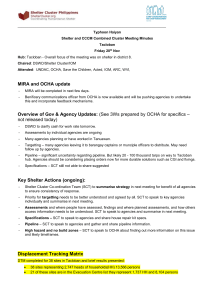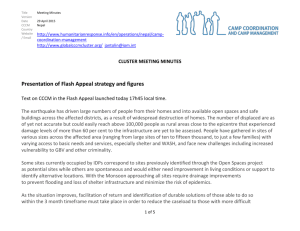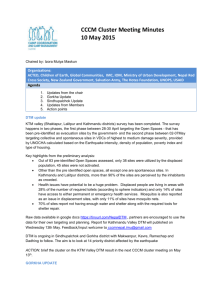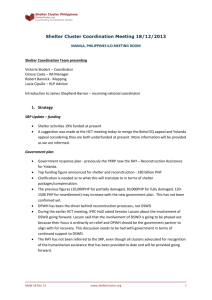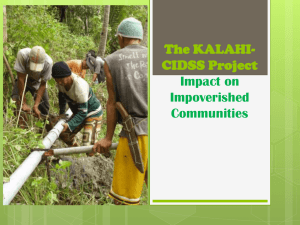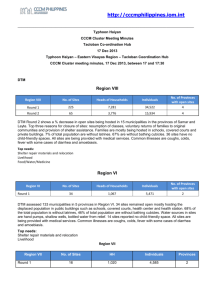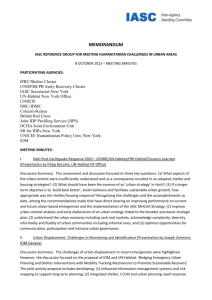Tacloban CCCM Meeting 23 Dec 2013
advertisement
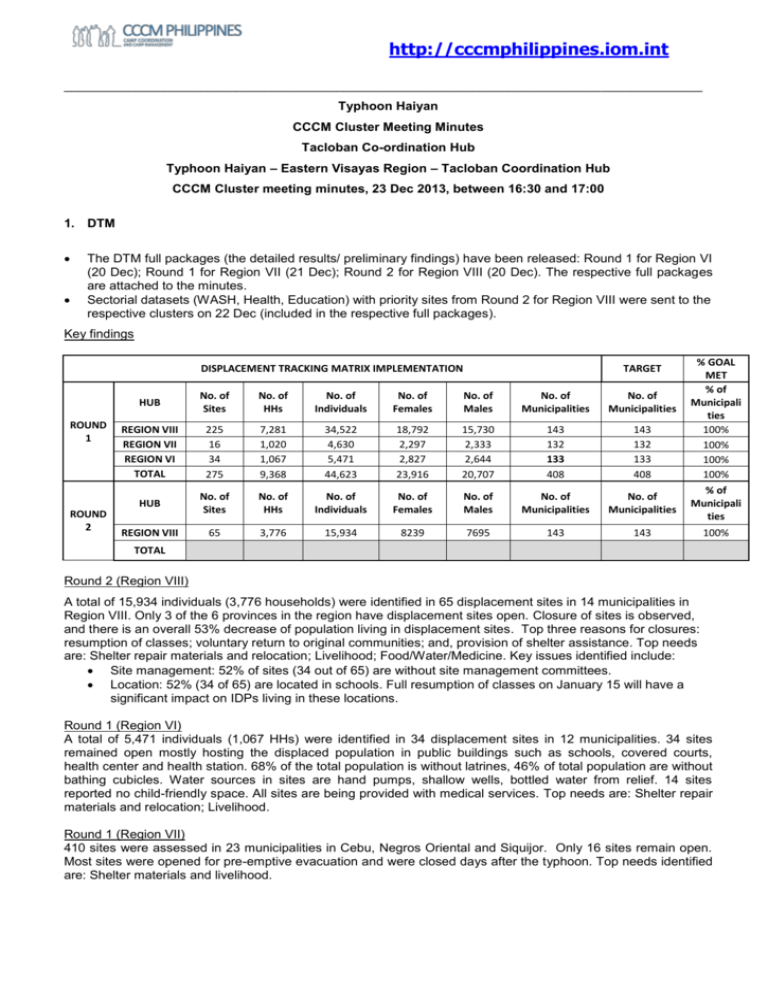
http://cccmphilippines.iom.int _________________________________________________________________________________________ Typhoon Haiyan CCCM Cluster Meeting Minutes Tacloban Co-ordination Hub Typhoon Haiyan – Eastern Visayas Region – Tacloban Coordination Hub CCCM Cluster meeting minutes, 23 Dec 2013, between 16:30 and 17:00 1. DTM The DTM full packages (the detailed results/ preliminary findings) have been released: Round 1 for Region VI (20 Dec); Round 1 for Region VII (21 Dec); Round 2 for Region VIII (20 Dec). The respective full packages are attached to the minutes. Sectorial datasets (WASH, Health, Education) with priority sites from Round 2 for Region VIII were sent to the respective clusters on 22 Dec (included in the respective full packages). Key findings DISPLACEMENT TRACKING MATRIX IMPLEMENTATION ROUND 1 ROUND 2 TARGET % GOAL MET % of Municipali ties 100% 100% 100% 100% HUB No. of Sites No. of HHs No. of Individuals No. of Females No. of Males No. of Municipalities No. of Municipalities REGION VIII REGION VII REGION VI TOTAL 225 16 34 275 7,281 1,020 1,067 9,368 34,522 4,630 5,471 44,623 18,792 2,297 2,827 23,916 15,730 2,333 2,644 20,707 143 132 133 408 143 132 133 408 HUB No. of Sites No. of HHs No. of Individuals No. of Females No. of Males No. of Municipalities No. of Municipalities % of Municipali ties REGION VIII 65 3,776 15,934 8239 7695 143 143 100% TOTAL Round 2 (Region VIII) A total of 15,934 individuals (3,776 households) were identified in 65 displacement sites in 14 municipalities in Region VIII. Only 3 of the 6 provinces in the region have displacement sites open. Closure of sites is observed, and there is an overall 53% decrease of population living in displacement sites. Top three reasons for closures: resumption of classes; voluntary return to original communities; and, provision of shelter assistance. Top needs are: Shelter repair materials and relocation; Livelihood; Food/Water/Medicine. Key issues identified include: Site management: 52% of sites (34 out of 65) are without site management committees. Location: 52% (34 of 65) are located in schools. Full resumption of classes on January 15 will have a significant impact on IDPs living in these locations. Round 1 (Region VI) A total of 5,471 individuals (1,067 HHs) were identified in 34 displacement sites in 12 municipalities. 34 sites remained open mostly hosting the displaced population in public buildings such as schools, covered courts, health center and health station. 68% of the total population is without latrines, 46% of total population are without bathing cubicles. Water sources in sites are hand pumps, shallow wells, bottled water from relief. 14 sites reported no child-friendly space. All sites are being provided with medical services. Top needs are: Shelter repair materials and relocation; Livelihood. Round 1 (Region VII) 410 sites were assessed in 23 municipalities in Cebu, Negros Oriental and Siquijor. Only 16 sites remain open. Most sites were opened for pre-emptive evacuation and were closed days after the typhoon. Top needs identified are: Shelter materials and livelihood. http://cccmphilippines.iom.int _________________________________________________________________________________________ DTM reports and materials attached are available at http://cccmphilippines.iom.int/ See health, wash, education specific kmz maps attached. And on overview of indicators for Region VIII. 2. TRANSITORY SITES - BUNKHOUSES Meeting on bunkhouses and their use was held on 19 Dec with attendance of Local Government Units (LGU) and cluster leads from CCCM, Shelter, Protection and WASH. The meeting purpose was to discuss concerns that humanitarian agencies have regarding the siting, layout and quality of bunkhouses and find ways to resolve these concerns. Key discussion points included: Adherence to standards; selection of beneficiaries; types of assistance provided; responsible agencies; exit/closure plan. Key agreed points included: All land issues to be agreed and resolved with a clear duration of site use; DSWD/ municipality/ humanitarian agencies will do pre site inspection to highlight problems to the Department of Public Works and Highways (DPWH); beneficiary selection process to be supported by cluster partners. For details, please see the attached technical recommendations for the bunkhouse sites in Tacloban. CCCM, WASH, Shelter, Protection and Early recovery clusters have prepared an advisory note and standards on bunk houses, to be released on the coming days from Manila. DSWD raised a concern that through their site visit, they’ve observed that bunkhouses in Palo, as in other locations are not following the international standards and the previous standards of bunkhouses used in other contexts (Sendong, Zamboanga, etc). The city government representative suggested DSWD to raise the concern to DPWH Secretary so as not to make this as an impediment to the scheduled bunkhouse handover from DPWH to DSWD. 3. CAMP MANAGEMENT Through working with DSWD, camp management support has been provided for the following 12 sites jointly by IOM, IEDA and IDRN. o Astrodome; San Fernando Elementary School; EVRMC; Rizal Central School; People’s Center; San Jose Elementary; Kapangi-an elementary school; Leyte national high school; Anibong elementary school; EVSU; Bgy 83-A health centre/ day care centre/ covered court; Iglesia ni cristo. CCCM trainings are organized on Fridays. For additional modules to be included (i.e. SGBV, Child Protection, Counter-trafficking) DSWD has requested the key priority modules to be shared before hand and a methodology approach to be shared for approval prior to integratingthem into the trainings. Next CCCM Cluster Meeting: UNLESS urgent matters require a meeting it will be on Tuesday January 7 at 5.00 pm, at OCD room in OSOCC-GrandStand Jean-Philippe Antolin Tacloban CCCM Cluster Co-Coordinator Mob +63 0926 724 5722 Email cccmtacloban@iom.int
